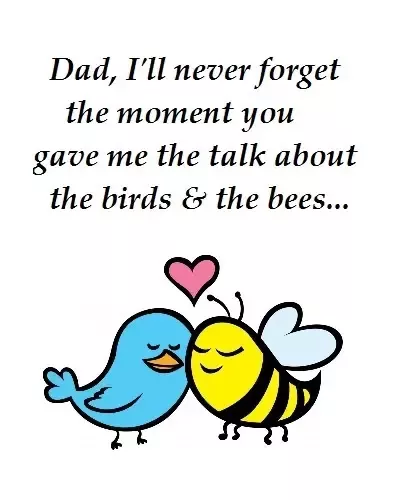Hey There, Super Parent! Ready to Navigate the Birds and the Bees?
Oh, the wonderful journey of parenting! From the first steps to the first words, and now perhaps to one of the most blush-inducing milestones—explaining the birds and the bees to your little ones. Take a deep breath, because you’ve got this, and we’re here to guide you every flutter and buzz of the way!
The “birds and the bees” is a phrase soaked in the dew of euphemism, blossoming from generation to generation. Essentially, it’s a colorful way of discussing human reproduction and sexuality with children in a manner that’s digestible, relatable, and—let’s face it—a tad less awkward. So kick back, and let’s chat about the best ways to approach this all-important conversation.
Timing is Everything: When to Have the ‘Talk’
Like the perfect moment to see the butterfly emerge from its chrysalis, timing is key. Most kids are ready to learn about the birds and the bees between the ages of 8 and 10, but you know your child best! Keep an eye out for signs of curiosity about where babies come from or the differences between boys and girls. These are great openings for a natural, organic conversation.
If you’re feeling unsure about when to initiate the talk, don’t fret! Staying attuned to your child’s development and cues will signal the right time for you both. And remember, this isn’t a one-and-done chat. It’s a series of discussions that will evolve as your child grows.
Preparation: Your Nest of Knowledge
Before you swoop into discussion, do a little nest-making of your own—gather resources! Books, diagrams, and even educational videos can be wonderful aids for explaining the complexity of reproduction in a way that kids can understand. These tools also serve as handy visual aids that can reduce the embarrassment factor for everyone.
Another key part of your preparation should be to consider your own feelings about this topic. Reflect on what values and information you want to impart. Clarifying these in your mind beforehand can help the conversation go smoothly and ensures you’re passing on the messages that are important to you and your family.
It’s All About the Dialogue: How to Keep Things Light and Engaging
Conversations about the birds and the bees can be sprinkled with giggles and red faces, but keeping a light-hearted tone can make this educational moment more comfortable for both, you and your child. When discussing these topics, use age-appropriate language and be honest. If they ask a question and you don’t have the answer, it’s perfectly fine to say, “Let’s find out together!” It’s a wonderful way to show your child that learning is a lifelong adventure.
Sometimes, the best chats happen during activities, like a walk in the park or while drawing. Engaging in something enjoyable together can create a relaxed environment where questions flow as freely as the crayons across the paper.
Be the Bee’s Knees: Emphasize Respect and Care
As you navigate the pollen-filled air of this talk, remember to weave in themes of respect, consent, and body positivity. It’s not just about the mechanics of how babies are made or how our bodies change during puberty; it’s also about forming a healthy outlook on our bodies and the bodies of others.
Tackle the topic with positivity and without shame, affirming that these processes are natural, beautiful, and worthy of respect. Your approach will lay the foundation for how your child views these subjects throughout their life. Make it count!
So, dear parents, as you set out to discuss the birds and the bees with your blooming buds, remember to approach it with cheer, a sprinkle of humor, and heaps of patience. After all, this is just one of the many conversations that will help your child blossom into a well-informed and respectful adult. Stay tuned as we dive deeper to ensure you’re fully equipped with the knowledge and skills to make “the talk” as smooth as a bee’s dance. Keep buzzing with positivity!

Five Key Things Parents Should Know When Preparing for “The Talk”
Let’s get into the nitty-gritty of preparation. There are a few golden nuggets of wisdom that can make your discussion about the birds and the bees as sweet as honey. Get ready to note these down!
-
Knowledge is Power (and Comfort!)
Gather as much information as you can about the topics you plan to discuss. When you’re well-versed in the subject matter, it not only boosts your confidence but also equips you to provide clear, accurate answers to your little one’s potentially tricky questions.
-
Embrace Your Child’s Curiosity
Curiosity about the birds and the bees is a natural and healthy part of growing up. Encourage your child to ask questions, and make sure they know that no question is silly or taboo. Foster an open line of communication that reassures your child they can always come to you.
-
Start Simple and Build Up
Begin with the basics and layer on more details as needed, based on your child’s age and level of understanding. A good starting point might be discussing the differences between male and female bodies, followed by explanation of conception and birth in a simple, clear way.
-
Make It a Dialogue, Not a Monologue
Instead of delivering a lecture, engage in a two-way conversation. Listen to what your child knows and thinks about the topic, and clarify any misconceptions they might have. This approach not only makes the conversation more interactive but also more informative for both parties.
-
Prepare for the Emotional Aspect
This talk isn’t just about biology; it’s also wrapped up in emotional and social issues. Be ready to discuss feelings, relationships, and responsibility in the context of sexuality. Covering these aspects is crucial in helping your child develop a well-rounded understanding of the topic.
Remember, the birds and the bees talk is part of a larger conversation about growth, respect, and healthy relationships. It’s about arming your child with knowledge and preparing them for the road ahead, with all of its twists and turns. So take a deep, calming breath, gather your resources, and get ready for one of the most rewarding parts of the parenting journey. Your little caterpillar is on the way to becoming a beautiful butterfly, and you’re the guide on this transformational flight.
A Peek into the Importance of Accurate Information and Healthy Attitudes
Part of the beauty of this conversation is instilling in your child a sense of wonder and respect for the miracle of life. In an age of information overload, where kids can stumble upon all sorts of content online, your role as a source of accurate and thoughtful information is more important than ever.
Discuss how life begins with that magical spark, and how each and every person, including them, started this way. Dive into the roles that both men and women play in creating new life, using scientifically correct terms, paired with the warmth and care that only a parent can provide.
Now, when you address puberty and the changes they can expect in their own bodies, emphasize that these changes are positive and part of growing up. Be honest about menstruation, wet dreams, and the development of secondary sexual characteristics. But also be sure to wrap these facts in the assurance that they’re common experiences for everyone and nothing to be ashamed of.
And finally, as your discussion naturally segues into the topics of love, intimacy, and consent, make sure to underscore the emotional and relational aspects of these experiences. Talk about the value of mutual respect and the importance of being in tune with one’s own feelings and boundaries, as well as those of others.
While these talks might initially feel as daunting as teaching a bee to swim, with preparation, patience, and positivity, you’ll navigate these waters like a seasoned pro, and your relationship with your child will be all the richer for it. Keep fluttering forward with love and wisdom, and watch as your little one takes wing into a future bright with understanding and mindfulness.
See more great Things to Do with Kids in New Zealand here. For more information see here
Disclaimer
The articles available via our website provide general information only and we strongly urge readers to exercise caution and conduct their own thorough research and fact-checking. The information presented should not be taken as absolute truth, and, to the maximum extent permitted by law, we will not be held liable for any inaccuracies or errors in the content. It is essential for individuals to independently verify and validate the information before making any decisions or taking any actions based on the articles.




